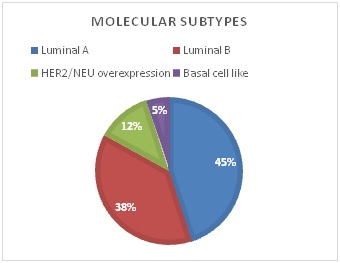ER, PR, M1B1 index and HER2/NEU status in 100 cases of Breast Carcinoma
Abstract
Background: Breast carcinomas are the most common cancers in women in our country. There have been various studies about the markers like ER/PR, HER2/NEU, HRAS, p53, Ki67 predicting response along with morphology and mitotic count.
Aim: To find out the prevalence of various molecular subtypes of breast cancers and correlate molecular subtypes and M1B1 index with histological features, clinical stage and other prognostic factors.
Materials and Methods: It is a prospective study of 100 cases of breast cancer operated in our hospital. All specimens were grossed and then stained using hematoxylin and eosin staining. They were staged according to TNM classification and further processed for immunostaining(ER, PR, Her2/neu and M1B1).
Results: Luminal A is the most common subtype and is associated with lower clinical stage.Higher M1B1 index is associated with higher aggressiveness.
Downloads
References
2. Asthana S, Chauhan S, Labani S. Breast and cervical cancer risk in India: An update. Indian J Public Health. 2014;58:5–10. [PubMed] [Google Scholar]
3. Murthy N S, Chaudhry K, Nadayil D, Agarwal U K, Saxena S. Changing trends in incidence of breast cancer: Indian scenario. Indian J Cancer 2009;46:73-4.[pubmed]
4. Haroon S., Hashmi A.A., Khurshid A. et al. (2013) Ki67 index in breast cancer: correlation with other prognostic markers and potential in Pakistani patients. Asian Pac. J. Cancer Prev. 14, 4353–4358 10.7314/APJCP.2013.14.7.4353
5. M. Perou, Charles & Sørlie, Therese & B. Eisen, Michael & van de Rijn, Matt & S. Jeffrey, Stefanie & Rees, Christian & R. Pollack, Jonathan & Ross, Douglas & Johnsen, Hilde & A. Akslen, Lars & Fluge, Øystein & Pergamenschikov, Alexander & Williams, Cheryl & Zhu, Shirley & Lønning, Per & Borresen-Dale, A.L. & Brown, Patrick & Botstein, David. (2000). Molecular portraits of human breast tumours. Nature. 406. 747-52. 10.1038/35021093.
6. Kumar N, Patni P, Agarwal A, Khan MA, Parashar N. Prevalence of molecular subtypes of invasive breast cancer: A retrospective study. Med J Armed Forces India. 2015;71(3):254–258. doi:10.1016/j.mjafi.2015.04.006.[pubmed]
7. Edge SB, Compton CC. The American Joint Committee on Cancer: the 7th edition of the AJCC cancer staging manual and the future of TNM. Ann Surg Oncol. 2010;17:1471–1474.[pubmed]
8. Nadji M, Gomez-Fernandez C, Ganjei-Azar P, Morales AR. Immunohistochemistry of estrogen and progesterone receptors reconsidered. Am J Clin Pathol. 2005;123(1):21–27. doi: 10.1309/4WV79N2GHJ3X1841].[pubmed]
9. Wolff AC, Hammond MEH, Hicks DG, Dowsett M, McShane LM, Allison KH et al. Recommendations for human epidermal growth factor receptor 2 testing in breast cancer: American society of clinical oncology/college of American pathologists clinical practice guideline update. Archives of Pathology and Laboratory Medicine. 2014 Feb;138(2):241-256. https://doi.org/10.5858/arpa.2013-0953-SA.[pubmed]
10. L. Fulawka and A. Halon, “Ki-67 evaluation in breast cancer: The daily diagnostic practice,” Indian J. Pathol. Microbiol., vol. 60, no. 2, p. 177, 2017.
11. Fulawka L, Halon A. Proliferation Index Evaluation in Breast Cancer Using ImageJ and ImmunoRatio Applications. Anticancer Res 2016;36:3965-72. Back to cited text no. 19
12. Dowsett M, Nielsen TO, A'Hern R, et al. Assessment of Ki67 in breast cancer: recommendations from the International Ki67 in Breast Cancer working group. J Natl Cancer Inst. 2011;103(22):1656–1664. doi:10.1093/jnci/djr393.[pubmed]
13. Bustreo S, Osella-Abate S, Cassoni P, Donadio M, Airoldi M, Pedani F, et al. Optimal Ki67 cut-off for luminal breast cancer prognostic evaluation: a large case series study with a long-term follow-up. Breast Cancer Res Treat. 2016;157:363–71.[pubmed]
14. Tashima R, Nishimura R, Osako T, Nishiyama Y, Okumura Y, Nakano M, et al. Evaluation of an Optimal Cut-Off Point for the Ki-67 Index as a Prognostic Factor in Primary Breast Cancer: A Retrospective Study. PloS one. 2015;10(7):e0119565. PubMed Central PMCID: PMC4503758. pmid:26177501
15. Verma S, Bal A, Joshi K, Arora S, Singh G. Immunohistochemical characterization of molecular subtypes of invasive breast cancer: A study from North India. APMIS 2012;120:1008-19.[pubmed]
16. Munjal K, Ambaye A, Evans MF, Mitchell J, Nandedkar S, Cooper K. Immunohistochemical analysis of ER, PR, HER2 and CK 5/6 in Infiltrative breast carcinomas in Indian patients. Asian Pac J Cancer Prev. 2009;10:773–8.[pubmed]
17. Ambroise M, Ghosh M, Mallikarjuna VS, Kurian A. Immunohistochemical profile of breast cancer patients at a tertiary care hospital in South India. Asian Pac J Cancer Prev 2011;12:625-9.[pubmed]
18. Tiwari Pandey, Smriti & Malik, Reeni & Trichal, VK & K Nigam, R & Rai, Arvind & Balani, Sharda & Jain, Jaya & Pandey, Dhruvendra. (2015). Breast Cancer: Correlation of Molecular Classification with Clinico-histopathology. Scholars Journal of Applied Medical Sciences (SJAMS). 3. 1018 - 1026.
19. Soliman NA, Yussif SM. Ki-67 as a prognostic marker according to breast cancer molecular subtype. Cancer Biol Med. 2016; 13: 496–504. pmid:28154782.[pubmed]
20. Spitale A, Mazzola P, Soldini D, Mazzucchelli L, Bordoni A. Breast cancer classification according to immunohistochemical markers: clinicopathologic features and short-term survival analysis in a population-based study from the South of Switzerland. Annals of oncology: official journal of the European Society for Medical Oncology / ESMO. 2009;20:628–35.[pubmed]
21. Jana D, Sarkar DK, Ganguly S, Banerjee A, Manna AK, Mandal S. Can molecular subtyping replace axillary nodal status as prognostic marker in breast cancer? Indian J Surg Oncol 2014; 5: 282-289.[pubmed]
22.Makki J. Diversity of Breast Carcinoma: Histological Subtypes and Clinical Relevance. Clin Med Insights Pathol. 2015;8:23–31. Published 2015 Dec 21. doi:10.4137/CPath.S31563.[pubmed



 OAI - Open Archives Initiative
OAI - Open Archives Initiative


